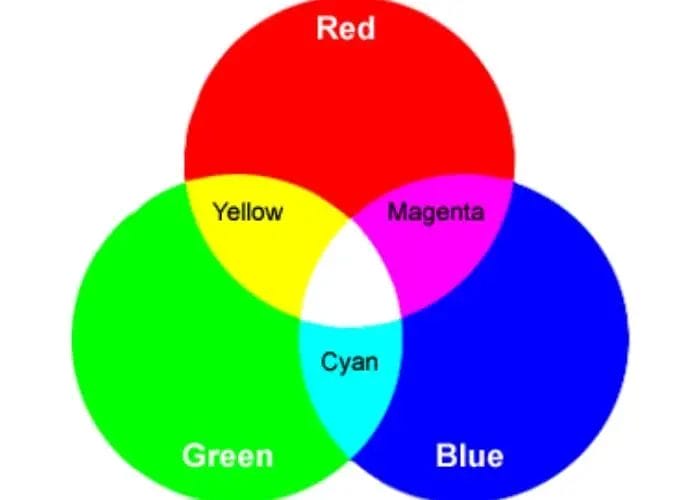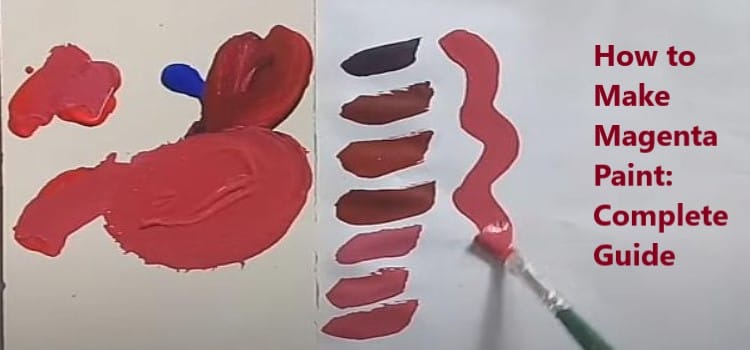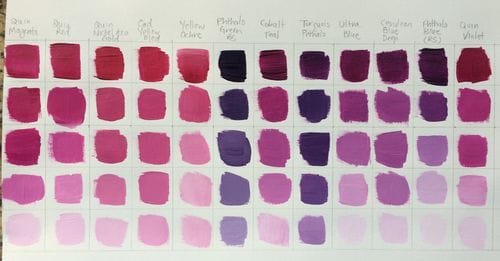Are you looking to create striking magenta acrylic paint? Look no further! In this guide, we will show you the step-by-step process of making your own magenta acrylic paint from scratch.
First, you’ll need a few key ingredients, including a red acrylic paint and a vibrant blue acrylic paint. By carefully blending these two colors together, you can achieve the perfect shade of magenta.
Start by adding small amounts of the red and blue paints onto a palette or mixing tray. Mix them together thoroughly using a palette knife or a brush until you achieve a smooth and consistent color.
If the color appears too red, add a touch more blue paint, and if it looks too blue, add a bit more red paint. Keep adjusting the ratio until you achieve the desired magenta shade.
Once you are satisfied with the color, you can start using your homemade magenta acrylic paint for a variety of artistic projects. Enjoy the process of creating your own unique color and let your creativity flow!

Mixing Primary Colors to Create Magenta Acrylic
Acrylic paint is a versatile medium that allows artists to create a wide range of colors by mixing different pigments. Magenta, a vibrant and intense hue, is a popular color choice among artists. While magenta paint can be purchased directly from art supply stores, mixing primary colors to create your own magenta acrylic can be a fun and cost-effective alternative. In this section, we will explore the process of mixing primary colors to achieve the desired magenta shade in acrylic paint.
Understanding Primary Colors
Before we delve into the process of mixing primary colors to create magenta, let’s first understand what primary colors are. Primary colors are a set of colors that cannot be created by mixing other colors together. In traditional color theory, the primary colors are red, blue, and yellow. However, in the subtractive color model, which is commonly used in paint mixing, the primary colors are magenta, yellow, and cyan.
Choosing the Right Pigments
To create magenta acrylic paint, we will need to have the right primary colors on hand. The primary colors required for mixing magenta are magenta (or a close shade of red), yellow, and blue. It is important to select pigments that are highly pigmented and have good color strength for optimal results.
The Color Mixing Process
Now that we have the necessary primary colors, let’s begin the process of mixing them to create magenta acrylic paint:
- Start by squeezing a small amount of magenta (or red) paint onto your palette.
- Add a small amount of yellow paint next to the magenta paint on your palette.
- Using a clean brush or palette knife, mix the magenta and yellow paint together. Start with small amounts and gradually add more yellow until you achieve a vibrant shade of orange.
- Once you have obtained the desired orange shade, add a small amount of blue paint to the mixture.
- Mix the blue paint into the orange mixture, adjusting the amount of blue until you achieve the desired shade of magenta. Remember, a little goes a long way, so add the blue paint incrementally to avoid overpowering the mixture.
- Continuously mix the paints together until the colors blend seamlessly, resulting in a smooth and consistent magenta hue.
- Test the color on a scrap piece of paper or canvas to ensure that it matches your desired shade. Make any necessary adjustments by adding more primary colors as needed.
Additional Tips
Here are a few additional tips to keep in mind when mixing primary colors to create magenta acrylic:
- Use a palette knife or a clean brush to mix the colors, ensuring that the pigments are thoroughly blended.
- Start with small amounts of paint and gradually add more as needed. It is easier to darken a color by adding more pigment than to lighten it.
- Consider the opacity and transparency of the paints you are using. Some pigments may require more layers to achieve the desired intensity.
- Keep a record of the ratios and colors used to create your custom magenta shade. This will help you recreate the color in the future if needed.
In summary, creating magenta acrylic paint by mixing primary colors can be a rewarding and creative process. By understanding the principles of color theory and experimenting with different ratios of primary colors, artists can achieve unique and vibrant magenta hues for their artwork.

Experimenting with different ratios for a desired magenta hue
When it comes to creating a specific magenta hue, there are various factors to consider, such as the colorants used and their ratios. Magenta is a vibrant and eye-catching color that can be achieved by mixing different pigments together, and finding the right ratio is key to obtaining the desired shade.
One popular pigment used to create magenta is quinacridone. Quinacridone pigments are known for their intense and transparent properties, making them an excellent choice for achieving vibrant magenta tones. However, the final color outcome can vary depending on the ratio of quinacridone to other colorants.
Experimenting with different ratios of quinacridone to other pigments can help you achieve the exact magenta hue you desire. This experimentation process allows you to fine-tune the color and make adjustments according to your preferences.
One common approach is to start with a base ratio of 1:1, combining equal parts of quinacridone with another colorant. This provides a good starting point to assess the color and make further adjustments.
For a warmer magenta hue, you may consider increasing the ratio of the other colorant while maintaining a smaller proportion of quinacridone. This can add a touch of red or yellow to the mix, resulting in a slightly different shade of magenta. On the other hand, if you prefer a cooler magenta hue, you can decrease the ratio of the other colorant and increase the proportion of quinacridone. This can introduce more blue undertones to the final color.
Keep in mind that the specific pigments you choose to mix with quinacridone will also impact the final outcome. Different pigments have different characteristics and undertones, which can influence the overall color appearance. It’s important to experiment with various combinations to find the perfect blend for your desired magenta hue.
A helpful technique during this experimentation process is to create small test swatches. By mixing small amounts of the pigments in different ratios, you can apply them to a surface and observe how they dry and interact with light. This allows you to assess the color accuracy and make any necessary adjustments before committing to a larger project.
In summary, achieving the perfect magenta hue requires experimentation with different ratios of quinacridone and other colorants. By adjusting the proportions and exploring various combinations, you can create a unique and personalized shade of magenta that meets your specific requirements. Remember to take into account the characteristics of the pigments used, and consider creating test swatches to evaluate the color accuracy. With patience and creativity, you can achieve the desired magenta hue that will make your artwork or design stand out.

Adding White or Black to Adjust the Opacity and Undertones of Magenta Acrylic
Magenta acrylic paint is a vibrant and versatile color that can be used in various art and craft projects. However, sometimes you may want to adjust the opacity or undertones of the magenta paint to achieve a specific effect or match a particular color scheme. One way to achieve these adjustments is by adding white or black to the magenta acrylic paint.
Adjusting Opacity with White
If you want to lighten the intensity of the magenta paint and make it more opaque, you can add white to it. Mixing white with magenta will create a lighter shade of pink, reducing the vibrancy of the magenta color. The amount of white you add depends on the desired opacity. Adding small amounts of white will result in a semi-opaque or pastel version of magenta, while adding more white will create a more opaque and lighter pink color.
To adjust the opacity, start by squeezing a small amount of magenta acrylic paint onto your palette. Then, add a small amount of white paint next to it. Use a palette knife or a brush to mix the two colors together. Keep adding white gradually until you achieve the desired opacity. Remember to mix the colors thoroughly to ensure an even distribution of pigments.
Adjusting Undertones with Black
If you want to change the undertones of the magenta paint, you can add black to create a darker shade. Adding black to magenta will result in a deeper and more muted color. The amount of black you add will determine the intensity of the undertones. Adding a small amount of black will create a subtle shift in undertones, while adding more black will result in a richer and darker hue.
To adjust the undertones, follow a similar process as with adjusting opacity. Start by squeezing a small amount of magenta paint onto your palette and add a small amount of black paint next to it. Mix the two colors thoroughly using a palette knife or a brush. Gradually add black until you achieve the desired undertone. Remember to mix well to ensure even color distribution.
Experimenting with Different Ratios
To achieve the perfect opacity and undertone adjustments, it’s essential to experiment with different ratios of magenta, white, and black. Start with small amounts of paint and gradually add more as needed. Keep in mind that the intensity of the magenta paint may vary depending on the brand and quality of the paint, so be prepared for slight variations in color when mixing.
As you experiment, consider keeping a record of the ratios used to achieve specific shades. This will help you replicate the colors in future projects or mix new shades based on your previous findings. It’s also worth noting that adding white or black to magenta paint can create an array of pastels, pinks, and deeper hues, allowing you to expand your color palette and explore different artistic possibilities.
In summary, adding white or black to magenta acrylic paint can help you adjust the opacity and undertones to achieve the desired effect in your art or craft projects. By experimenting with different ratios and mixing techniques, you can create a wide range of shades and colors that complement your artistic vision.
Tips for Blending and Layering Magenta Acrylic for Smooth and Vibrant Results
Acrylic painting offers a wide range of possibilities when it comes to creating vibrant and striking artwork. One color that can add a pop of energy to your paintings is magenta. Blending and layering magenta acrylic can help you achieve smooth and vibrant results. In this section, we will explore some helpful tips to master the art of blending and layering with magenta acrylic.
1. Start with a Proper Base
Before you begin blending and layering magenta acrylic, it is important to establish a solid base. Make sure to prime your canvas or surface with a layer of gesso to create a smooth and even foundation. This will allow your magenta acrylic to adhere better and prevent any unwanted textures from interfering with your blending and layering techniques.
2. Build up Layers Gradually
Layering is the key to achieving depth and richness in your magenta acrylic paintings. Instead of applying a thick layer of magenta all at once, start with thin washes and gradually build up the color. This will allow you to have more control over the blending process and create a smoother transition between different shades of magenta.
3. Use a Wet-on-Wet Technique
The wet-on-wet technique involves applying wet paint onto a wet surface. This technique is useful for blending colors seamlessly. To blend magenta acrylic, wet your brush with water or a blending medium and apply the color onto the wet surface. Use gentle strokes to blend the edges of the magenta with other colors or with additional layers of magenta. This technique will create a smooth transition and prevent any harsh lines or color separation.
4. Experiment with Different Tools
Blending and layering magenta acrylic can be enhanced by using various tools. Try using a palette knife, sponge, or even your fingers to create different textures and effects. These tools can help you achieve interesting and unique blends in your artwork.
5. Work in Thin Layers
When layering magenta acrylic, it is essential to work in thin layers. Thick layers may take longer to dry and can result in uneven drying, leading to cracks or uneven color distribution. Apply thin layers of magenta acrylic, allowing each layer to dry completely before adding another layer. This will ensure a smooth and even application of the color.
6. Practice Color Theory
Understanding color theory is vital when blending and layering magenta acrylic. Experiment with complementary colors, such as greens or blues, to create visual interest and balance in your artwork. By incorporating different color combinations, you can enhance the vibrancy and depth of your magenta acrylic paintings.
7. Take Breaks and Step Back
Blending and layering magenta acrylic can be an intense process. It is important to take breaks and step back from your artwork to assess your progress. This will give you a fresh perspective and help you identify areas that need adjustments or additional blending. Sometimes, stepping back and taking a break can lead to fresh ideas and new approaches to your artwork.
8. Practice and Experiment
Like any skill, mastering the art of blending and layering with magenta acrylic requires practice and experimentation. Try out different techniques, explore various color combinations, and don’t be afraid to make mistakes. Each painting will provide valuable insights and improve your understanding of how magenta acrylic reacts with other colors and surfaces.
By following these tips and dedicating time to practice, you can achieve smooth and vibrant results when blending and layering magenta acrylic. Remember to have fun and let your creativity flow as you explore the possibilities of this versatile color.
FAQs
1. How can I make magenta acrylic paint?
To make magenta acrylic paint, you will need to mix equal parts of red and blue acrylic paint. Start by adding a small amount of each color to a palette or mixing surface, and gradually increase the amount until you achieve the desired shade of magenta. Remember to mix the colors thoroughly to ensure an even and vibrant result.
2. What colors do I need to mix to create magenta?
Magenta is a secondary color, which means it is created by mixing two primary colors. To create magenta, you will need to mix equal parts of red and blue paint. By combining these two colors, you can achieve various shades of magenta, depending on the specific hues and brands of paint you are using.
3. Can I create magenta by mixing other colors?
No, magenta is a unique color that cannot be created by mixing other basic colors. While you can create similar shades by mixing red and blue, true magenta is a specific hue that requires the combination of red and blue pigments in equal proportions.
Conclusion
In conclusion, learning how to make magenta acrylic paint is a fun and creative process that allows artists to customize their color palette. By mixing equal parts of primary colors, specifically red and blue, one can create a vibrant and rich magenta shade. It is important to experiment with different ratios and shades to achieve the desired hue. Whether you are a professional artist or a beginner, creating your own magenta acrylic paint can add a personal touch to your artwork and expand your artistic possibilities. So, grab your paintbrushes and start mixing to bring your imagination to life with the beautiful magenta color!
